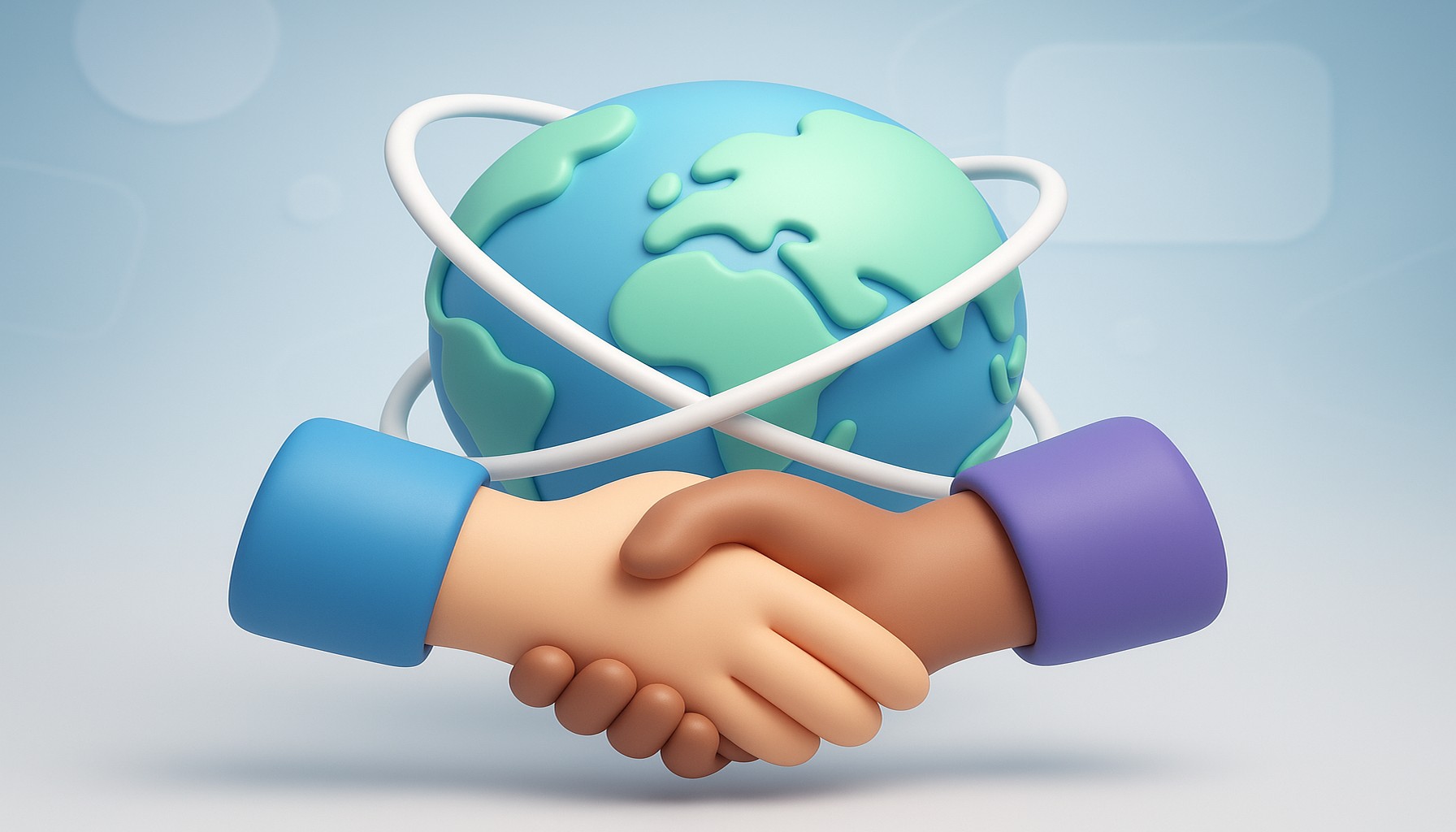
Click the button to start reading
Top Strategies to Score Big in the Customer Acquisition Game
Customer acquisition is like playing chess. In chess, you need to think ahead to capture your opponent’s pieces and win the game. Similarly, when adopting a customer acquisition strategy, you must carefully plan your moves to acquire new customers and ultimately win the market.
Here’s when effective strategies become irreplaceable.
This blog post will help you with three important tasks. One is to pick the best customer acquisition strategy for your business. Two, learn real-world examples of customer acquisition strategy. Three, clearly understand how to apply a customer acquisition framework to your business.
But before we dive in, let’s get on the same page about a key definition.
What is a customer acquisition strategy?
View your business as a digital playground and your customers as players. You should attract and engage the customers to keep them coming back for more. But how?
Correct! You bring into play your strategy for customer acquisition.
Simply put, a customer acquisition strategy is a plan designed to attract and convert potential buyers into paying customers. This strategy involves identifying your target audience, understanding their needs and preferences, and creating a roadmap to reach them.
Here’s a way to visualize the customer acquisition process:

In other words, your customer acquisition strategy is your plan for capturing the hearts and minds of your target audience.
Now, let’s cover two questions that may quite naturally arise.
Customer acquisition vs. marketing: What’s the difference?
These are related concepts but aren’t the same.
In essence, marketing is about getting your brand out there and generating interest, while customer acquisition is about transforming that interest into actual purchases.
Here’s an example. You own a coffee shop in a busy downtown area and aim to attract more people to your shop. You start by placing ads on social media, promoting your shop’s unique atmosphere, high-quality coffee, and delicious baked goods. In addition, you sponsor local events or host your own events to create buzz and raise awareness of your brand. That’s marketing.
However, this may not be enough to convert potential customers into actual customers. To do that, you might offer special promotions to people who recommend your brand or sign up for your loyalty program. These customer acquisition strategies aim to turn potential customers into paying customers over time.
Lead generation vs. customer acquisition: Understanding the difference.
Although related, lead generation and customer acquisition are two different aspects of the sales process.
Leads have expressed interest in what you offer, but they aren’t yet ready to make a purchase. So, the goal of lead generation is building a database of potential customers who’ll later become actual customers.
Conversely, customer acquisition involves guiding leads through the sales funnel until they’re willing to pay for what you offer.
For example, a software company might generate leads by offering a free trial of its product. Afterwards, they might use targeted email marketing campaigns to eventually convert them into paying customers.
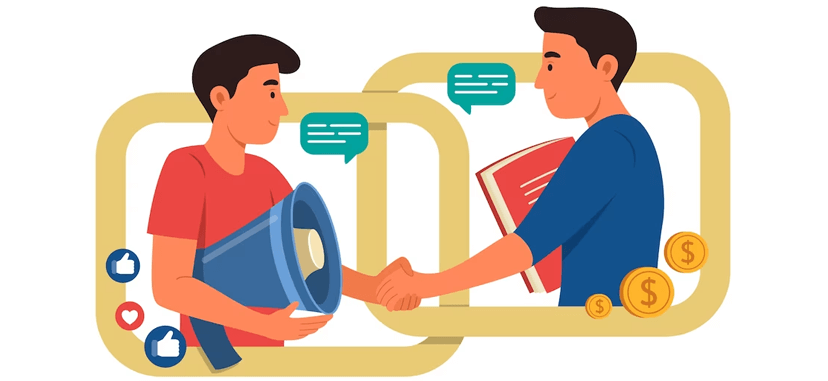
Customer acquisition strategy: A framework to apply
The customer acquisition framework refers to a broad approach to customer acquisition that involves a set of strategies and processes. Mainly, it represents the tactics for both acquiring and retaining customers.
Basically, a customer acquisition framework means making sure everything in your business works together to get more customers. It’s like putting all the puzzle pieces in the right places to create a picture.
Four steps to creating a new customer acquisition strategy
A customer acquisition strategy is a key component of any successful business. By identifying your audience and choosing the right channels and tactics, you can attract and convert potential customers into loyal customers.
Step 1: Identify your ideal customers.
The first step in crafting a customer acquisition strategy is identifying your ideal customer. Who are they? What are their pain points? What motivates them to buy? The moment you clearly understand your target audience, you can tailor your efforts to appeal to them specifically.
Also, you need to know what sets your business apart from the competition. Maybe you offer a unique experience, a variety of products, or innovative elements that your competitors don’t have. By highlighting these strengths, you can attract customers who’re looking for something new and exciting.
Step 2: Choose your customer acquisition channels.
Once you know who to target, it’s time to plot your course. Will you set sail on the sea of social media, where the waters are choppy, but the rewards can be great? Will you trek through email marketing, where the path is treacherous, but the payoff can be huge? Or maybe a combination of these and other channels?
Step 3: Nurture your relationships.
Remember that gaining a new customer is only the beginning of the relationship. The real work comes in retaining and engaging that customer over the long term.
Whether it’s through personalized content, special offers, or exclusive access to events, consistently provide value to your customers. Say loudly and clearly that you care about their needs, and you’ll build trust and create a sense of loyalty.
Another tactic is to encourage feedback and actively listen to your customers’ concerns. This shows that you value their input. Responding to their feedback in a timely and thoughtful manner will help customers feel seen and heard.
Furthermore, focus on creating a sense of community around your brand. True, it’s a customer acquisition strategy that requires time and commitment. But it’s one of the best strategies to drive engagement and a deeper connection to your brand.
Step 4: Measure and adapt.
As you journey forth, you’ll need to stay nimble and adaptable. The terrain may change, and your target audience may shift. That’s why it’s important to adjust your strategy for customer acquisition accordingly.
Track the effectiveness of your new customer acquisition strategy attentively. The advantages and drawbacks of your tactics will quickly jump out. Next, you’ll be able to make adjustments and optimize your approach over time.

Two quick formulas to jumpstart your customer acquisition strategy
How to define customer lifetime value (LTV)
Customer lifetime value (LTV) is a critical metric. It helps businesses understand the total value of a customer over time. In other words, it indicates the net profit that someone will bring throughout their lifetime as a customer.
To calculate LTV, you need to determine three parameters:
- the average value of a purchase made by the customer,
- the number of purchases they make over a given period, and
- the average duration of their relationship with the business.
Here is the formula to calculate LTV:
LTV = (Average Value of a Sale) x (Number of Repeat Transactions) x (Average Retention Time)
For example, let’s say a company has an average sale of $100, and a customer makes two purchases per year. The average customer relationship lasts for three years. Using the formula above, the LTV would be calculated as follows:
LTV = $100 x 2 x 3 = $600
Thus, on average, each customer contributes $600 to the company’s profits over the duration of their relationship with the business.
By understanding the LTV of your customers, you can make informed decisions about your strategies, customer acquisition costs, and customer retention efforts.
How to define customer acquisition cost (CAC)
Customer acquisition cost (CAC) is the total cost a business invests to acquire a new customer. This includes all the marketing and sales expenses, such as advertising, sales commissions, salaries of marketing and sales teams, and other overhead costs. To calculate the CAC, the total cost is divided by the number of customers acquired.
Here’s the formula for calculating customer acquisition cost:
CAC = Total cost of sales and marketing / Number of new customers acquired
For example, if a company spent $100,000 on marketing and sales in a given period and acquired 1,000 new customers, the CAC would be $100.
Calculating the CAC is important for businesses for two main reasons. First, it helps them evaluate the effectiveness of their customer acquisition strategy. Second, it helps to determine the return on investment (ROI) of their marketing and sales efforts.

Best customer acquisition strategies to gain an edge in the market
Discover the top customer acquisition strategies that will take you a step closer to succeeding in today’s market.
Search engine optimization: Boosting your online visibility.
SEO (Search Engine Optimization) is the practice of optimizing your website to be loved by search engines.
By improving your website’s visibility in search results, you can drive more traffic to your webpages and potentially convert that traffic into paying customers. This is what makes SEO a top choice for those who’re seeking a new customer acquisition strategy.
Keyword research: For obvious reasons, one of the key elements of SEO is keyword research. This involves identifying the specific words and phrases people use when they go online to search for products or services like yours. By incorporating those keywords into your website’s content, you can improve your website’s relevance. As a result, your brand authority will rise in the eyes of users (and search engines).
On-page optimization: To make your website more search engine-friendly, you need to optimize your website’s structure, content, and metadata. For example, you might ensure that your website’s SEO-related texts accurately describe the content on your site, including title tags and meta descriptions.
Off-page optimization is another critical part of SEO. You should consider building links from other websites to your site. Why? Because this is how search engines understand that your site is a credible hub of information. Off-page optimization includes tactics like guest blogging, influencer outreach, and social media marketing.
SEO as a customer acquisition strategy: Example of a company you can learn from.
The Wirecutter
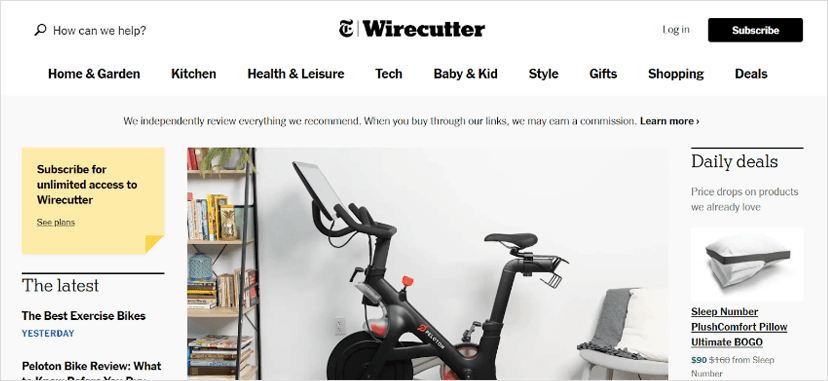
The Wirecutter is a product review site that was acquired by the NY Times in 2016. They’ve built their business by providing in-depth, unbiased product reviews that are optimized for search engines.
By conducting thorough keyword research, they intentionally target the right keywords that their audience is searching for. Moreover, they have a strong link-building strategy that has helped them earn backlinks from authoritative sites, further boosting their search engine rankings.
Through these efforts, they’ve been able to rank highly in SERPs for a variety of relevant keywords. As a result, Wirecutter manages to consistently drive a large amount of organic traffic to its site.
Blogging: Establishing authority and driving traffic through consistent writing.
Blogging is a customer acquisition strategy that involves creating high-quality content on your website. By consistently publishing informative and engaging blog posts, you see where your opportunities are and how to attract more customers to your pages.
But blogging doesn’t end there. You should also invest resources and efforts to promote your blog posts. For this, a set of tactics are recommended: having a regular calendar for sharing your blog posts on social media channels (more on this in a second), sending them by email newsletters, and guest posting on other blogs.
When you leverage all relevant channels, you increase your reach and attract new potential customers to your site.
Social media marketing: Connecting with your audience where they are.
Building brand awareness, increasing your reach, and driving more sales. These are the key benefits social media marketing can bring. And this is why social media continues to be a big part of every business’s marketing efforts.
To attract new customers through social media, consider an important tactic. Use targeted advertising and audience segmentation to reach people who are likely to have a genuine interest in your brand.
As a rule, social media marketing can be used without tons of resources. That’s why it’s one of the best customer acquisition strategies for startups.
Product pricing: Finding the sweet spot between value and profitability.
Just think of it. The way you price your product can be a strategy for customer acquisition.
Free trial and freemiums: Offering a free trial of your product is a recognized way to attract new customers. Allow people to test-drive your product before making a commitment, and you can easily demonstrate the value of your offering.
For the strongest results, be sure to provide helpful resources and support. Remember, during the free trial, your potential customers should have a positive experience. By the way, even if they don’t become paying customers themselves, they’ll spread the word about your brand and recommend you to those who’re searching for a similar solution.
Be cautious. A free trial can be a significant investment for your business. So, it’s important to put forth much effort in tracking your results and measuring the ROI of your efforts. This way, you’ll refine your strategy over time and optimize your investment to attract the highest quality customers.
Price anchoring: Another common approach to pricing is to use price anchoring, which involves setting a high price point for a premium product and then offering lower-priced options. Reportedly, this creates a perception of value and makes the lower-priced options more attractive to potential customers.
Dynamic pricing: Are you in a field where seasonality has a big impact on your sales? In this case, an effective approach will be to use dynamic pricing. Consider adjusting the price of your product based on demand, supply, or seasonality. This can help you optimize your pricing to attract the highest quality customers and maximize revenue.
Customer acquisition strategy: Examples of using the freemium pricing model successfully.
In the freemium pricing model, you offer the basic version of your product or service free of charge. But you charge for additional features or functionality.
Many successful companies have used freemiums as a strategy for customer acquisition to great effect.
Dropbox

Who doesn’t know Dropbox? And who hasn’t used the free version of its service? Enter your username and password and get your gigabytes of storage free! But you have to pay for additional storage and advanced features.
The company’s freemium model has been highly successful. Reportedly, it helped Dropbox acquire millions of users and reach a leading position in the cloud storage industry.
Spotify

The free option of Spotify is a stripped-down version of the full service, with limited functionality and advertisements interspersed between songs.
However, the platform’s free version still provides access to a vast library of music and allows users to create playlists. What’s more, users can upgrade to a premium subscription at any time to be able to download songs and listen offline.
The free trial has been a successful strategy for Spotify. Many users are willing to give the platform a try when there is no upfront cost. Additionally, the company has used various marketing tactics to encourage opting for a free trial. These tactics include offering exclusive content or collaborations with popular artists.
Video marketing: Engaging your audience with dynamic visual content.
Video is the ultimate canvas for bringing your brand to life and igniting the imagination of your audience. That’s why it’s a dynamic medium to captivate and connect with your customers. In fact, a report by Animoto states that 93% of businesses gained a new customer after posting a video on social media.
Video content allows you to offer an immersive experience to your audience and make a lasting impression. It can be how-to guides, tutorials, product review videos, influencer videos, video live streams, behind-the-scenes vlogs, etc.
Creating high-quality videos may require resources and experienced staff. However, if you don’t have a lot of experience with video production, you can make use of technological solutions. Bring in tools like video editing software or animation software to create professional-looking content.
Email marketing: Driving conversions with targeted messaging.
Not only a means to acquire new leads, email marketing is an effective customer acquisition and retention strategy.
Build a quality email list: When using email marketing as a customer acquisition strategy, focus on maintaining a clean and verified email list. By identifying and removing “toxic” emails from your list, you can increase the effectiveness of your email marketing campaigns. Plus, adopt ethical email-gathering practices and never add contacts to your list without permission.
Use email retargeting: All too often, you’ll come across customers who are somewhat interested in your business but haven’t completed a purchase. Most probably, they need a clearer path to action or a gentle push to make their first purchase. You can achieve this by sending them targeted and personalized emails based on their previous interactions with your brand.
For example, suppose a customer has added items to their shopping cart but hasn’t completed the purchase. In that case, you can send them an email reminder about the items in their cart. You can even think of an incentive to entice them to complete the purchase. Or, if a customer has visited your website but hasn’t made a purchase, you can send them a personalized email with product recommendations based on their browsing history.
Companies that rocked the email marketing strategy for gaining new customers
Without a doubt, email marketing can be a powerful strategy for customer acquisition. The reason is email marketing helps to keep your subscribers engaged, leading to increased sales and revenue over time.
Copyhackers

Copyhackers specializes in copywriting and content marketing. They have a large email list of subscribers (89k and counting) and are known for their effective email marketing strategies.
Copyhackers sends tips and advice on copywriting, as well as promotions for their online courses and resources. Also, they use targeted emails to promote their webinars and events, thus building their brand and attracting new customers.
Airbnb
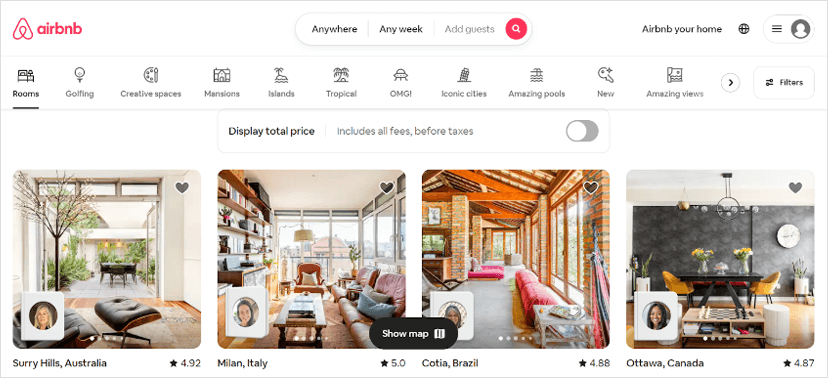
Airbnb has built a large email list by offering a discount on the first booking for new subscribers. In addition, Airbnb sends emails to subscribers based on their travel preferences and previous bookings. This way, they’re able to keep subscribers engaged and interested in the platform.
Client spotlights and case studies: Highlighting the success stories of your happy customers.
Success stories are invaluable. But, to truly unlock their potential, you need to give your customers a platform to sing your brand’s praises.
To create effective customer spotlights, be sure to choose customers who are delighted by your offering. By the way, spotlights can take a variety of formats: written case studies, video interviews, or social media posts.
Gated content: Using exclusivity to capture leads and drive engagement
Many businesses provide valuable content in exchange for their visitor’s contact information. It’s called gated content – content that promises exclusive access to those who are willing to provide their contact information or perform a certain action. This exclusivity can create a sense of value and prestige around the content, making it more desirable and enticing.
But should you open the gates to all your content? In fact, the proven tactic is to adopt a hybrid approach.
A hybrid approach means that you “gate” some of your content while making other content available to everyone. The key is to ensure that you gate the right content at the right time in your customer’s journey.
Examples of offering gated content as a strategy for customer acquisition
Here are two companies that have excelled at using gated content to acquire new customers:
HubSpot

HubSpot offers a variety of free resources to its website visitors. These resources include ebooks, whitepapers, webinars, and other educational content on topics such as social media, SEO, and email marketing. But to access the content, users must provide their contact information. Afterwards, HubSpot uses this data to nurture its leads with targeted emails and marketing campaigns.
Moz
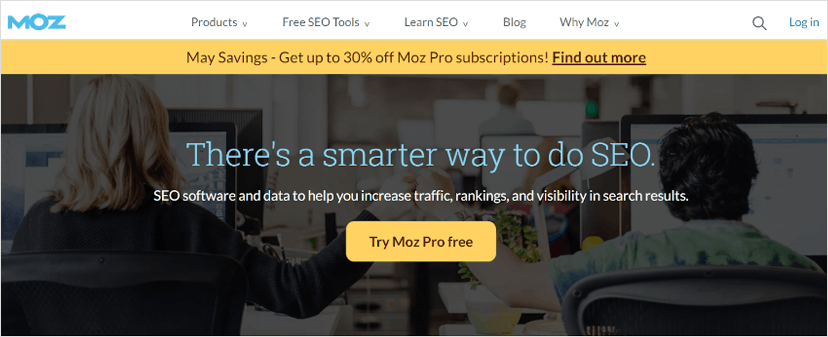
Moz is a marketing analytics company that can boast of its free tools and resources. If you’re in the marketing or content writing field, most probably, you’ve already used one of their tools.
For example, they offer a link analysis tool and a keyword research tool. But to access the advanced tools and content, you must sign up for a free trial.
Events: Creating memorable experiences and excitement
Have you ever attended a business event that left you feeling invigorated, inspired, and excited about a company’s products or services? That’s the power of events as a customer acquisition strategy.
Events can take many forms, from trade shows and product launches to networking events and conferences. However, the key is to create an experience that resonates with attendees and leaves a lasting impression.
By leveraging events as a customer acquisition strategy, businesses can engage with potential customers in a way that goes beyond traditional marketing tactics. They can create an environment where attendees can see, touch, and interact with products or services, ask questions, and receive answers in real time.
Events as a customer acquisition strategy: Examples of companies that have used this strategy successfully.
Many companies excel at acquiring customers through events, but here are a few examples:
Salesforce
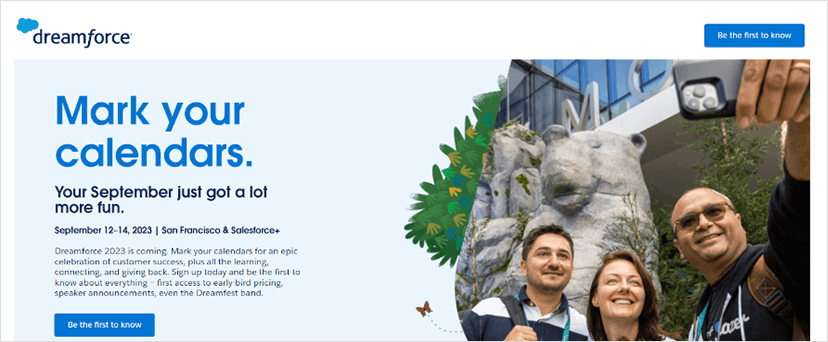
Salesforce is a global player in customer relationship management (CRM) software and is known for its annual conference, Dreamforce. Dreamforce brings together thousands of industry professionals, thought leaders, and Salesforce customers for a week of networking, education, and inspiration. The event has become a platform for Salesforce to showcase its products and services and serves as a viable strategy for customer acquisition.
Adobe

Adobe hosts an annual event, Adobe MAX, which brings together creatives, designers, and developers for a week. The event features keynote speakers, hands-on workshops, and educational sessions. By focusing on the latest trends and innovations in design and digital marketing, Adobe MAX serves as a major platform for Adobe to showcase its products and services. And, ultimately, attract new customers.
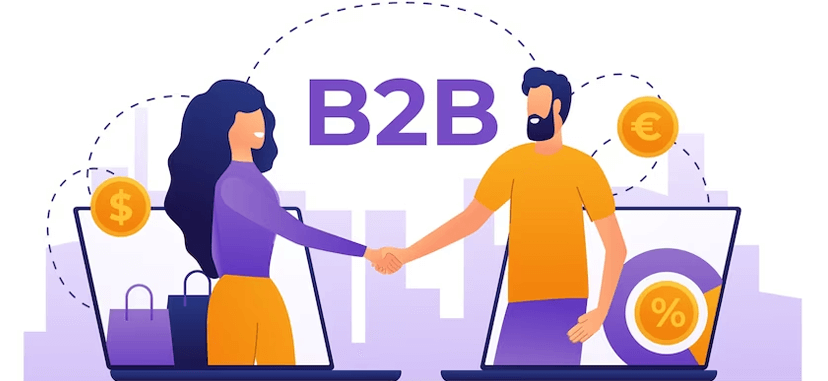
B2B customer acquisition strategy
Note that when choosing the best customer acquisition strategy, the B2B world has its peculiarities. As a rule, any B2B customer acquisition strategy is focused on acquiring new business customers. But unlike B2C, B2B customer acquisition is more complex and involves a longer sales cycle.
The reason is B2B customers often require more detailed information, custom solutions, and a higher level of personalization. Therefore, the strategy needs to be well-planned and executed with precision.
To build an effective framework for B2B customer acquisition strategy, consider developing a customer profile. It should include demographics, company size, budget, and decision-making authority. This is essential to understand who makes decisions in a company to be able to speak directly to them.
Secondly, nurture leads. B2B customers often require more nurturing before they make a purchase. You need to create a lead nurturing program that includes regular follow-ups, personalized content, and a clear path to conversion.
Conclusion
Prioritize customer acquisition strategies and make them the driving force behind your business. With this, you not only position yourself for success in the market but also set the foundation for sustainable growth.
A well-executed customer acquisition and retention strategy can help you reach your desired audience, cultivate brand awareness, and foster long-term relationships with your customers.
Don’t hesitate to invest time, effort, and resources into developing a winning customer acquisition strategy. Your business and bottom line will be forever grateful!





